Sana'a
| Sana'a صنعاء Ṣan‘ā’ |
|
|---|---|
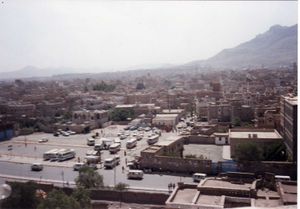 |
|
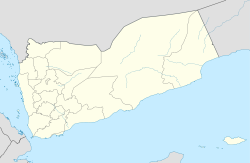 Sana'a
|
|
| Coordinates: | |
| Country | |
| Admin. division | San‘a’ Governorate |
| Government | |
| - Type | Local |
| - Mayor: Abdulrahman al-Akwaa& | Ahmed Al-Douaid |
| Elevation | 7,382 ft (2,250 m) |
| Population (2004) | |
| - City | 1,747,627 |
| - Metro | 2,167,961 |
| Time zone | GMT+3 |
Sana'a (Arabic: صنعاء, pronounced [sˤɑnʕaːʔ]; also spelt Sanaa or Ṣan‘ā’) is the capital of Yemen and the centre of San‘a’ Governorate. Sana'a is one of the oldest continuously inhabited cities in the world. At an altitude of 2,300 meters, it is also one of the highest capital cities in the world. Sana'a has a population of 1,747,627 (2004 census), making it Yemen's largest city.
Contents |
History
Sana'a is one of the ancient Yemeni cities dating back to the Sabaean dynasty of the 6th century BC. The oldest written reference to its existence is found in inscriptions which date back to the 1st century AD. It is suggested that Sana'a was the capital of the Himyarite kingdom at the onset of the 6th century AD.
When King Yousef Athar (or Dhu Nuwas), the last of the Himyarite kings, was in power, Sana'a was also the capital of the Ethiopian viceroys.
As of the dawn of Islam until the detachment of independent sub-states in many parts of Yemen Islamic Caliphate, Sana'a persisted as the governing seat, who himself is Caliph's deputy in running the affairs of one of Yemen's Three Makhalifs: Mikhlaf Sana'a, Mikhlaf al-Janad and Mikhlaf Hadhramawt. The city of Sana'a recurrently assumed an important status and all Yemenite States competed to control it.
The Mamelukes arrived in Yemen in AD 1517. Following the collapse of the Mamelukes in Egypt at the hands of the Ottoman Turks, Yemen fell under the Ottoman rule and during the first Ottoman rule of Yemen between 1538–1635, Sana'a became the capital of the Ottoman wilayah and also during the Ottoman second rule 1872-1918. In 1918, Sana'a was the capital of Imam Yahya, who ruled North Yemen. At the onset of the 1962 revolution which deposed the imamate rule, it became the capital of the Yemen Arab Republic. It was then the capital of unified Yemen in 1990 where it is dubbed as the historical capital of Yemen. In 2008, the Saleh Mosque was completed. It holds over 40,000 worshippers.

| Old City of Sana'a* | |
|---|---|
| UNESCO World Heritage Site | |
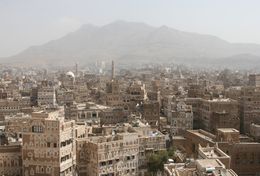 |
|
| State Party | |
| Type | Historic, Cultural |
| Criteria | IV, V, VI |
| Reference | 385 |
| Region** | Arab States |
| Inscription history | |
| Inscription | 1986 (10th Session) |
| * Name as inscribed on World Heritage List. ** Region as classified by UNESCO. |
|
Main sights and culture
Old City
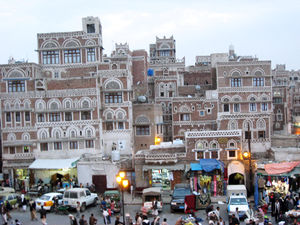
The old fortified city has been inhabited for more than 2,500 years, and contains a wealth of intact architectural gems. It was declared a World Heritage City by the United Nations in 1986. Efforts are underway to preserve some of the oldest buildings, some of which are over 1400 years old like the Samsarh or the old Mosque. Surrounded by ancient clay walls which stand 9–14 metres (30–46 ft) high, the old city boasts over 100 mosques, 12 hammams (baths) and 6,500 houses. Many of the houses resemble ancient skyscrapers, reaching several stories high and topped with flat roofs. They are decorated with elaborate friezes and intricately carved frames and stained glass windows.
One of the most popular attractions is Suq al-Milh (Salt Market), where it is possible to buy not only salt but also bread, spices, raisins, cotton, copper, pottery, silverware, antiques (both fake and real) and formerly, slaves. The majestic 7th century Jami' al-Kabir (Great Mosque) is one of the oldest in the Muslim world. The Bāb al-Yaman (Yemen Gate) is an iconized entry point through the city walls and is over 1000 years old.
A commercial area of the old city is Al Madina, where development is proceeding rapidly. In addition to three large hotels, there are numerous stores and restaurants. The area also contains three parks and the President's palace.
Cultural Arab Capital
Sana'a was designated as the Arab Cultural Capital for the year of 2004.
Demographic evolution
|
|
Economy
Yemenia, the national airline of Yemen, has its head office in Sana'a.[1]
Transportation
Sana'a International Airport is Yemen's main domestic and international airport. The airport will be expanded by 2010. There is no rail network currently but one will also be built. The best way around the city is dababs which are like minibuses holding about 10 people. Taxis are also a very common form of public transport at Yemen and in the recent years, Yemen has started using higher quality cars and companies are starting to take over the taxi business which could add more comfort to passengers with great services by both Marhaba and Al-Raha. There are many coaches to other major cities like Aden, Taiz and many more.
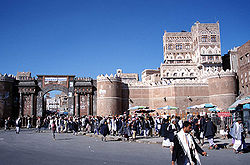
Quotes and impressions
"La budda min Ṣanʻāʼ" (Sana'a must be seen) are famous words first attributed to Imam Muḥammad ibn Idris al-Shafiʼi (768-820) who visited the ancient capital several times.
Many travellers in ancient days were impressed by the beauty of Sana'a. The well-known Yemeni geographer and historian al Hamdani marveled at the cleanliness of the city:
| “ | The least dwelling there has a well or two, a garden and long cesspits separate from each other, empty of ordure, without smell or evil odors, because of the hard concrete (adobe and Cob probably) and fine pastureland and clean places to walk. | ” |
The Persian traveller Ibn Rustah, a contemporary of al-Hamdani, noted its food:
| “ | It is the city of Yemen - there not being found ... a city greater, more populous or more prosperous, of nobler origin or more delicious food than it... | ” |
The British writer Jonathan Raban devotes a chapter of his 1979 book, 'Arabia Through the Looking Glass' to Sana'a. He initially found the city disorienting:
| “ | Suddenly in Sana'a I was in the middle of a real maze. Its walls were oppressively high, its corridors narrow, its noise frightening. ... Sana'a was functioning exactly as a labyrinth should: it was a close protective hive for insiders; but for an outsider it was a trap with no apparent means of escape. | ” |
Later, as he became more familiar with the place, and had made more acquaintances with its residents, he becomes admiring. In one striking sequence where he is invited onto the roof of somebody's home, the cityscape is revealed to him in a different way:
| “ | It was like stepping out into the middle of a vast pop-up picturebook. Away from the street, the whole city turned into a maze of another kind, a dense, jumbled alphabet of signs and symbols. The stucco friezes on the towers formed a continuous scrawl of handwriting around. You could look at the walls of Sana'a for a year, finding more and more hidden meanings in them. | ” |
Climate
Sana'a features the very rare mild version of a desert climate. Sana'a sees on average approximately 200 mm of precipitation per year. However, due to its high elevation, temperatures are much more moderate than many other cities on the Arabian Peninsula. In fact, average temperatures remain relatively constant throughout the year in Sana'a, with its coldest month being January and its warmest month in July. The city seldom experiences extreme heat or cold. However, some areas around the city can see temperatures fall to around 15 or 20 degrees Fahrenheit during winter. Sana'a receives half of its annual rainfall during the months of July and August. Rainfall comes depending on the year; some years could see 500–600 mm of rainfall, while others can barely get 150 mm.
| Climate data for Sana'a (2250 m) | |||||||||||||
|---|---|---|---|---|---|---|---|---|---|---|---|---|---|
| Month | Jan | Feb | Mar | Apr | May | Jun | Jul | Aug | Sep | Oct | Nov | Dec | Year |
| Average high °C (°F) | 19.8 (67.6) |
20.2 (68.4) |
22.8 (73) |
25.5 (77.9) |
26.0 (78.8) |
27.1 (80.8) |
27.7 (81.9) |
25.9 (78.6) |
23.7 (74.7) |
22.0 (71.6) |
20.7 (69.3) |
19.7 (67.5) |
23.43 (74.17) |
| Average low °C (°F) | 5.1 (41.2) |
8.0 (46.4) |
9.7 (49.5) |
11.5 (52.7) |
13.6 (56.5) |
15.8 (60.4) |
16.7 (62.1) |
16.3 (61.3) |
12.4 (54.3) |
9.1 (48.4) |
6.8 (44.2) |
6.2 (43.2) |
10.93 (51.68) |
| Precipitation mm (inches) | 0.0 (0) |
2.0 (0.079) |
9.9 (0.39) |
14.7 (0.579) |
4.7 (0.185) |
17.8 (0.701) |
49.9 (1.965) |
63.6 (2.504) |
24.0 (0.945) |
7.5 (0.295) |
4.4 (0.173) |
0.0 (0) |
198.5 (7.815) |
| Source: National Weather Service | |||||||||||||
See also
- Mahwa Aser
- Sana'a manuscripts fragments from over 1000 early Qur'an codices, discovered at the Great Mosque in Sana'a in 1972.
References
External links
- "The Old Walled City of San`a", 113 page book by Ronald Lewcock for Unesco
- "Sana'a - City of lights. The German-French Cultural Project 2007. Weblog"
- Eric Hansen, Sana'a rising, Saudi Aramco World, 2006. Vol. 57 No. 1
- Tim Mackintosh-Smith, The Secret Gardens of Sana'a. Saudi Aramco World, 2006 Vol. 57 No. 1
- Traditional housing in the old quarter of Sanaa in 1972
|
|||||||
|
|||||||||||
|
|||||